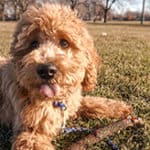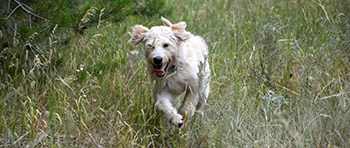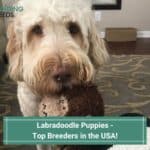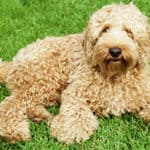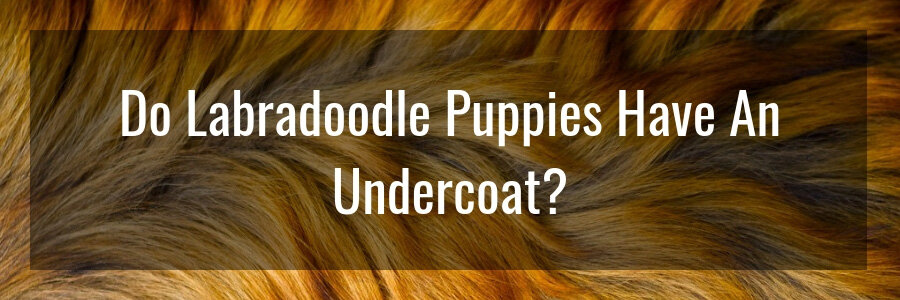
Of all the things that make Labradoodle dogs popular, their coat is probably at the top of the list, despite their coat requiring regular maintenance. Labradoodle puppies have various kinds of coats, mostly due to their genetics. Touted as being a low-shed to no-shed breed leaves many wondering what makes their coats different from other breeds.
So you might be wondering, do Labradoodle puppies have an undercoat like so many other breeds do? Yes, Labradoodles do, indeed, have an undercoat. This is a trait inherited from their Labrador Retriever genes. They simply don’t shed their undercoat like most undercoated breeds do. For this reason, regular brushing is important for Labradoodles as it removes the dead undercoat. If left uncared for, this dead undercoat leads to matting which it difficult to deal with and painful for the dog.
The breeding practices used have a significant effect on the type of coat a Labradoodle puppy has and can also affect its undercoat. First generation Labradoodle puppies, for example, are 50% Labrador Retriever and 50% Poodle. Breeders can then breed offspring from this litter with another Labradoodle to further change coat and physical traits. This practice is known as Multi-Generational Breeding.
What Kind of Coats Do Labradoodles Have?
Labradoodles generally have one of three kinds of coats:
- Hair (or wavy) coat – Dogs with a hair coat are generally F1 Labradoodles, which means they’re 50% Labrador Retriever and 50% Poodle. The hair may vary in length and thickness, and may be straight or somewhat wavy. This coat is closer to what you’d see in the Lab than with the Poodle. A Labradoodle with a hair coat may be chosen by someone who loves the Labrador Retriever but doesn’t want a dog that sheds as much as the Lab.
- Fleece coat – This coat is often the most popular of the Labradoodle coats. Popularity probably comes from the fact that it’s easy to care for and has very little shedding. The fleece coat has the appearance of wool but is a little shaggier. When the dog is standing still, the fleece coat has light, silky and loose locks that tend to ripple and flow when the dog moves. This coat can require quite a bit of maintenance when the dog is transitioning from puppy coat to adult coat. There are different types of fleece coats. They may be thick or fine, curly, wavy, or even straight.
- Wool coat – The Labradoodle with the wool coat generally has the least amount of undercoat if any at all so, therefore, there is very little shedding. The wool coat is thicker, curlier, thicker, and denser than fleece and hair coats, is similar to a sheep’s coat and gives the dog the appearance of the Poodle rather than the Labrador Retriever. This coat does not have the same “doggie odor” as the other two coats, and when it gets wet, it smells more like wet wool than like wet dog.
Different Coat Types and Their Characteristics
Labradoodles are available in three different coat types. Some buyers may choose their Labradoodle because they want Labradoodles while others may be after a specific coat type for a specific reason. One may require less maintenance, and one might shed less or be better for allergy and asthma sufferers. Each Labradoodle coat type is unique and has its own set of characteristics.
- Hair – The hair coat is probably the least popular of the three because its undercoat sheds the most and it has the most odor of the three. This coat, similar to the Labrador Retriever, is usually found in first-generation breeding because this dog is 50% Poodle and 50% Labrador Retriever.
- Fleece – The fleece coat has a soft texture like an Angora goat. It’s fairly easy to manage and can have a soft spiraling curl or a straight wavy look. It’s a very popular coat for its appearance and allergy-friendly attributes. The fleece-coated Labradoodle may be normal fleece or micro-fine fleece. The micro-fine fleece is very soft and fine and must be brushed to make sure mats don’t form. Mats in a micro-fine fleece coat can turn into little balls like tumbleweed.
- Wool – The wool coat is usually non-shedding and lacks the unappealing doggy odor of the hair coat. The wool coat gets its name because it has the softness of the lamb’s wool. The wool coat may be regular wool, cotton wool (a new style) or loose wool. The cotton wool is softer than the regular wool and is similar to a big cotton ball in appearance and touch. The wool coat has been the most successful in terms of being asthma and allergy-free. It should be noted that while these dogs don’t shed much, all dogs shed to some degree.
What Is An Undercoat?
The undercoat is exactly what the name implies. It’s a second coat of hair that’s underneath the top coat. Dogs that have an undercoat generally have a coat that’s coarser and longer than those without an undercoat. While the Labradoodle’s upper coat is long and coarse, the undercoat is usually soft and fluffy and almost wooly in texture.
It’s also usually lighter in color than the outer coat. Other breeds of dogs with an undercoat usually shed hair throughout the year but only shed the undercoat twice a year. This process is referred to as “blowing the coat”. A person who owns a double-coated dog (dog with an undercoat) may find regular brushing is sufficient to prevent shedding until one day there appears to be fur everywhere. This is usually when the dog is blowing his coat. This process can take a full week even with brushing the dog every day. Labradoodles do not blow their coats though so you wont have the shedding issue, just maintenance through brushing.
Because so much of the dog’s hair is shedding everywhere, it’s hard to determine if it’s coming from the upper or undercoat. Most of it is coming from the undercoat. It’s very important to brush the dog regularly using a comb or brush that gets right down to the skin so you can remove the loose undercoat hair before it has a chance to get tangled and matted.
How Does Having Or Not Having An Undercoat Impact A Dog?
One of the most important roles the undercoat plays is that it acts as insulation, keeping the dog cool in the summer and warm in the winter. When we see double-coated dogs in the hot weather, we often think the dog must be miserable because he or she has so much hair. The truth is that they are much more comfortable than a dog without an undercoat because of the protection provided by the undercoat. While the outer coat helps repel dirt and moisture, the undercoat protects the dog from extreme cold or hot temperatures.
Some dog owners who have double-coated dogs try to shave the dog in an attempt to eliminate shedding and hair loss. Shaving doesn’t really help because you’d be shaving the outer coat, and most of the shedding is coming from the undercoat. Shaving a double-coated dog is not a good idea for several reasons.
- Shaving it will not reduce shedding.
- It can damage the hair and result in it growing back patchy, thin, fluffy or too coarse
- It reduces the protection against insect bites.
- Shaving will not help with allergies.
- Shaving can increase the risk of sunburn, overheating and skin cancer.
Undercoat’s Impact on Shedding
A dog’s undercoat has a huge impact on shedding mostly because most of the shedding is coming from the undercoat. As you’re brushing your dog, you’ll notice that you’re removing hair from the top and bottom, but the majority of the hair that’s shedding is coming from the undercoat. When the dog begins to “blow its coat”, many owners are overwhelmed with the hair they find all over the house.
While the double-coated dog will shed its outer coat once a year, it will generally blow its undercoat twice a year usually just before winter and again in the spring. Because the purpose of the undercoat is to protect the dog from inclement weather temperatures, the dog sheds the undercoat to prepare for the new season.
The warm undercoat that protects the dog in the cold winter months is shed in the spring when it’s no longer needed. It’s replaced with a protective summer undercoat. The result of this process, unfortunately, is hair, hair, and more hair everywhere. Thorough brushing with an undercoat rake can be very helpful in keeping the shedding to a minimum or at least getting rid of the hair before it finds its way all over the house.
Related Questions
What dog breeds do have undercoats?
Many dogs have an undercoat, including Huskies, German Shepherds, Pomeranians, Malamutes, Chows, Collies, Shelties, Golden Retrievers, Akita, Newfoundland, and Labrador Retrievers.
How Often Should You Brush Your Labradoodle Puppy?
As a puppy, the Labradoodle should be brushed every day so it becomes accustomed to being brushed and groomed. Brushing regularly also decreases the chances of the hair/fur becoming matted. Trying to brush through matted hair can cause pain and discomfort for the puppy. An adult Labradoodle should be brushed anywhere from once a day to once or twice a week depending on the type and length of the coat.
Concluding Thoughts
Your Labradoodle’s coat is probably its strongest characteristic and definitely the one that requires the most attention. Providing your Labradoodle with regular grooming will not only make him look better and be as hypoallergenic as possible but will also make your dog very happy!

